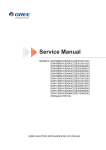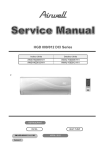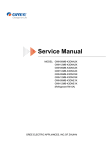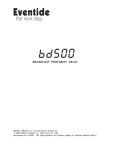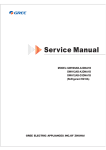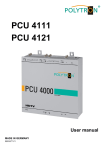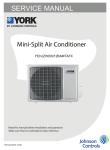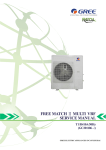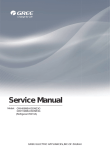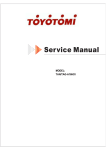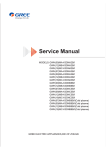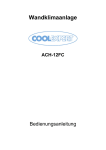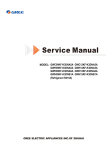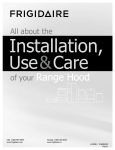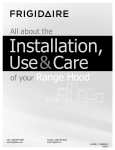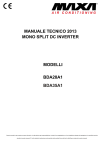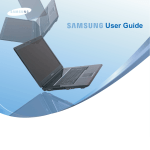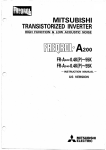Download Service Manual
Transcript
Service Manual MODEL: GWH09RA-K3DNA1A GWH12RB-K3DNA1A (Refrigerant R410A) GREE ELECTRIC APPLIANCES,INC.OF ZHUHAI Table of Contents Summary and features..................................................................................1 Part 1 Safety Precautions..........................................................................................2 Part 2 Specifications.....................................................................................................3 2.1 Unit Specifications..................................................................................................3 2.2 Operation Characteristic Curve..............................................................................5 2.3 CapacityVariation Ratio AccordingtoTemperature.................................................5 2.4 Operation Data.......................................................................................................6 2.5 Noise criteria curve tables for both models............................................................6 Part 3 Construction Views........................................................................................7 3.1 Indoor Unit .............................................................................................................7 3.2 Outdoor Unit ..........................................................................................................7 Part 4 Refrigerant System Diagram.....................................................................9 Part 5 Schematic Diagram......................................................................................10 5.1 Electrical Data......................................................................................................10 5.2 Electrical Wiring....................................................................................................10 5.3 Printed Circuit Board............................................................................................12 Part 6 Function and Control...................................................................................15 6.1 Remote Control Operations..................................................................................15 6.2 Changing Batteries and Notices ..........................................................................19 6.3 Description of Each Control Operation.................................................................20 Part 7 Installation Manual........................................................................................25 7.1 Notices for Installation...........................................................................................25 7.2 Installation Drawing..............................................................................................27 7.3 Install Indoor Unit.................................................................................................28 7.4 Install Outdoor Unit ..............................................................................................29 7.5 Check After Installation and Test Operation.........................................................30 7.6 Installation and Maintenance of Healthy Filter......................................................31 Table of Contents Part 8 Exploded Views and Parts List..............................................................32 8.1 Indoor unit.............................................................................................................32 8.2 Outdoor unit..........................................................................................................34 Part 9 Troubleshooting...............................................................................................38 9.1 Malfunction Analysis.............................................................................................38 9.2 Malfunction Code ................................................................................................42 9.3 How to Simply Check the Main Part....................................................................45 Part10 Removal Procedure.......................................................................................55 10.1 Removal Procedure of Indoor Unit.....................................................................55 10.2 Removal Procedure of Outdoor Unit...................................................................60 Summary and features Summary and features Indoor Unit GWH09RA-K3DNA1A/I GWH12RB-K3DNA1A/I Outdoor Unit GWH09RA-K3DNA1A/O GWH12RB-K3DNA1A/O Remote control 1 Safety Precautions 1.Safety Precautions Installing, starting up, and servicing air conditioner can be Make sure the outdoor unit is installed on a stable, level hazardous due to system pressure, electrical components, and surface with no accumulation of snow, leaves, or trash equipment location, etc. beside. Only trained, qualified installers and service personnel are Make sure the ceiling/wall is strong enough to bear the allowed to install, start-up, and service this equipment. weight of the unit. Untrained personnel can perform basic maintenance functions Make sure the noise of the outdoor unit does not disturb such as cleaning coils. All other operations should be neighbors. performed by trained service personnel. Follow all the installation instructions to minimize the risk When handling the equipment, observe precautions in the of damage from earthquakes, typhoons or strong winds. manual and on tags, stickers, and labels attached to the equipment. Follow all safety codes. Wear safety glasses and Avoid contact between refrigerant and fire as it generates work gloves. Keep quenching cloth and fire extinguisher nearby poisonous gas. when brazing. Apply specified refrigerant only. Never have it mixed with Read the instructions thoroughly and follow all warnings or any other refrigerant. Never have air remain in the cautions in literature and attached to the unit. Consult local refrigerant line as it may lead to rupture and other hazards. building codes and current editions of national as well as local Make sure no refrigerant gas is leaking out when electrical codes. installation is completed. Should there be refrigerant leakage, the density of Recognize the following safety information: refrigerant in the air shall in no way exceed its limited value , or it may lead to explosion . Warning Caution Incorrect handling could result in Keep your fingers and clothing away from any moving personal injury or death. parts. Incorrect handling may result in minor injury, or damage to product Clear the site after installation. Make sure no foreign objects are left in the unit. Always ensure effective grounding for the unit. or property. Warning Caution All electric work must be performed by a licensed technician Never install the unit in a place where a combustible gas according to local regulations and the instructions given in this might leak, or it may lead to fire or explosion. manual. Make a proper provision against noise when the unit is installed at a telecommunication center or hospital. Before installing, modifying, or servicing system, main Provide an electric leak breaker when it is installed in a electrical disconnect switch must be in the OFF position. watery place. There may be more than 1 disconnect switch. Lock out and Never wash the unit with water. tag switch with a suitable warning label. Handle unit transportation with care. The unit should not be Never supply power to the unit unless all wiring and tubing carried by only one person if it is more than 20kg. are completed, reconnected and checked. Never touch the heat exchanger fins with bare hands. This system adopts highly dangerous electrical voltage. Never touch the compressor or refrigerant piping without Incorrect connection or inadequate grounding can cause wearing glove. personal injury or death. Stick to the wiring diagram and all Do not have the unit operate without air filter. the instructions when wiring. Should any emergency occur, stop the unit and disconnect Have the unit adequately grounded in accordance with the power immediately. local electrical codes. Have all wiring connected tightly. Loose connection may lead to overheating and a possible fire hazard. All installation or repair work shall be performed by your dealer or a specialized subcontractor as there is the risk of fire, electric shock, explosion or injury. 2 Properly insulate any tubing running inside the room to prevent the water from damaging the wall. Specifications 2.Specifications 2.1 Unit Specifications Parameter Model Product Code Power Supply Value Unit GWH09RA-K3DNA1A GWH12RB-K3DNA1A CB14400020 CB14400030 Rated Voltage V̚ 220-240 220-240 Rated Frequency Hz 50 50 1 1 Indoor Indoor Phases Power Supply Mode Cooling Capacity (Min̚Max) W 2500(500̚3200) 3500(950̚4000) Heating Capacity (Min̚Max) W 2750(800̚3500) 3750(880̚4300) Cooling Power Input (Min̚Max) W 623 (280-1200) 960(350̚1250) Heating Power Input (Min̚Max) W 669 (310-1350) 1010(340̚1360) Cooling Power Current A 2.72 4.50 Heating Power Current A 2.91 4.60 Rated Input W 1350 1300 Rated Current A 5.88 6.00 Air Flow Volume(SH/H/M/L/SL) 3 m /h L/h 600/500/400/300/- 600/500/400/300/- Dehumidifying Volume 0.8 1.4 EER W/W 4.01 3.64 COP W/W 4.11 3.71 SEER W/W / / HSPF W/W / / Application Area m 2 Model of indoor unit Fan Type 16-24 GWH12RB-K3DNA1A/I Cross-flow Cross-flow Diameter Length(DXL) mm ĭ92X645 ĭ92X645 Fan Motor Cooling Speed (SH/H/M/L/SL) r/min 1260/1070/900/730/- 1290/1070/900/690/- Fan Motor Heating Speed (SH/H/M/L/SL) r/min 1280/1050/980/920/- 1280/1050/980/920/- Output of Fan Motor W 20 20 Fan Motor RLA A 0.10 0.10 Fan Motor Capacitor ȝF 1.0 1.0 Input of Heater W Evaporator Form Indoor Unit 12-18 GWH09RA-K3DNA1A/I / / Aluminum Fin-copper Tube Aluminum Fin-copper Tube ĭ7 ĭ7 Pipe Diameter mm Row-fin Gap mm 2-1.4 2-1.4 Coil Length (LXDXW) mm 690X24.8X266.7 690X24.8X266.7 MP24AA MP24AA Swing Motor Model Output of Swing Motor W 2 2 Fuse A 3.15 3.15 Sound Pressure Level (SH/H/M/L/SL) dB (A) 41/38/35/32/- 42/39/36/33/- Sound Power Level (SH/H/M/L/SL) dB (A) 51/48/45/42/- 52/49/46/43/- mm 845X275X180 845X275X180 Dimension (WXHXD) Dimension of Carton Box (L/W/H) mm 923X264X356 923X264X356 Dimension of Package (L/W/H) mm 926X267X371 926X267X371 Net Weight kg 10 10 Gross Weight kg 13 13 3 Specifications Model of Outdoor Unit GWH09RA-K3DNA1A/O Compressor Manufacturer/Trademark ZHUHAI LANDA COMPRESSOR CO.,LTD./GREE Compressor Model QXA-A086zC190 GWH12RB-K3DNA1A/O PANASONIC WANBAO COMPERSSOR (GUANGZHOU) CO.LTD/PANASONIC 5RS102ZJA21 FVC68D FV50S Rotary Rotary Compressor Oil Compressor Type L.R.A. A 25.00 25.00 Compressor RLA A 12.00 4.47 Compressor Power Input W Overload Protector Throttling Method 940 985 INT11L-6233 1NT11L-5270 Capillary Capillary Operation temp ºC 16̚30 16̚30 Ambient temp (cooling) ºC 18̚43 18̚43 Ambient temp (heating) ºC Condenser Form -7̚24 -7̚24 Aluminum Fin-copper Tube Aluminum Fin-copper Tube Pipe Diameter mm ĭ7 ĭ7.94 Rows-fin Gap mm 2-1.4 2-1.4 Coil Length (LXDXW) mm 695X38.1X508 870X38X580 Fan Motor Speed rpm 830 660/900 W 30 30 Output of Fan Motor Outdoor Fan Motor RLA Unit Fan Motor Capacitor Air Flow Volume of Outdoor Unit A 0.30 0.15 ȝF / / 3 1600 1800 Axial-flow Axial-flow ĭ400 ĭ400 Automatic Defrosting Automatic Defrosting T1 T1 m /h Fan Type Fan Diameter mm Defrosting Method Climate Type Isolation Moisture Protection I I IP24 IP24 Permissible Excessive Operating Pressure for the Discharge Side MPa 3.8 3.8 Permissible Excessive Operating Pressure for the Suction Side MPa 1.2 1.2 Sound Pressure Level (H/M/L) dB (A) 50/-/- 52/-/- Sound Power Level (H/M/L) dB (A) 60/-/- 62/-/- Dimension (WXHXD) mm 776X540X320 848X540X320 Dimension of Carton Box (L/W/H) mm 848X360X580 878X360X580 Dimension of Package (L/W/H) mm 851X363X595 881X363X595 Net Weight kg 29 36 Gross Weight kg 33 39 R410A R410A 0.9 1.12 Refrigerant Refrigerant Charge Length Gas Additional Charge Connecti Outer Diameter Liquid Pipe on Pipe Outer Diameter Gas Pipe kg m 5 5 g/m 30 50 mm ĭ6 ĭ6 mm ĭ9.52 ĭ9.52 Max Distance Height m 10 10 Max Distance Length m 15 20 The above data is subject to change without notice. Please refer to the nameplate of the unit. 4 Specifications 2.2 Operation Characteristic Curve Cooling Heating 8 10 9 7 8 6 12K 12K 7 5 Current(A) Current(A) 6 09K 5 4 3 Condition Indoor:DB 27 WB19 Indoor air flow: Turbo Pipe length:5m Voltage:230V 2 09K 4 3 Condition Indoor:DB 20 Indoor air flow:Turbo Pipe length:5m Voltage:230V 2 1 1 0 0 0 20 40 60 80 100 0 120 20 Compressor Speed(rps) 40 60 80 100 120 5 10 Compressor Speed(rps) 2.3 Capacity Variation Ratio According to Temperature Heating 110 120 100 100 90 80 Capacity ratio(%) Capacity ratio(%) Cooling 80 70 60 Condition Indoor:DB27℃ WB19℃ Indoor air flow: Turbo Pipe length:5m 50 32 33 34 35 36 37 38 39 40 41 42 43 44 45 46 Outdoor temp. (°C) 60 40 Condition Indoor:DB20℃ Indoor air flow: Turbo Pipe length:5m 20 0 -15 -10 -5 0 Outdoor temp. (°C) 5 Specifications 2.4 Operation Data Cooling Temperature condition (°C) Indoor Outdoor 27/19 35/24 Model name 09K 12K Standard pressure P (MPa) 0.85~1.0 Heat exchanger pipe temp. Indoor fan Outdoor fan mode mode T1 (°C) T2 (°C) in:8~11 out:11~14 in:75~85 out:37~43 Compressor revolution (rps) Turbo 830 54 Turbo 900 60 Heating Temperature condition (°C) Indoor Outdoor 20/- 7/6 Model name 09K 12K Standard pressure P (MPa) 2.5~3.0 Heat exchanger pipe temp. T1 (°C) T2 (°C) in:75~85 out:37~43 in:1~3 out:2~5 Indoor fan mode Outdoor fan mode Compressor revolution (rps) Turbo 830 62 Turbo 900 66 NOTES : ( 1 ) T1: Inlet and outlet pipes temperatures of evaporator; T2: Inlet and outlet pipes temperatures of condenser; P: Pressure of gas pipe which connects indoor unit to outdoor unit (on the gas valve side). (2) Measure surface temperature of heat exchanger pipe around center of heat exchanger path U bent. (Thermistor themometer) (3) Connecting piping condition : 5 m 2.5 Noise Criteria Curve Tables for Both Models Indoor side noise when blowing 54 40 Heating 52 12K Noise dB(A) Noise dB(A) 50 30 48 46 Cooling 44 09K 42 20 40 Low Middle Indoor fan motor rotating speed 6 High 20 30 40 50 60 Compressor frequency(Hz) 70 80 Constrction views 3. Construction Views 3.1 Indoor Unit 845 275 180 130 542 173 3.2 Outdoor Unit Unit:mm 09K Unit 257 776 320 540 712 286 510 7 Constrction views 12K Unit 257 540 848 320 286 763 540 Unit:mm 8 Refrigerant System Diagram 4. Refrigerant System Diagram INDOOR UNIT OUTDOOR UNIT 4-Way valve HEAT EXCHANGER (EVAPORATOR) Accumlator Compressor HEAT EXCHANGER (EVAPORATOR) Strainer Capillary/EEV Strainer COOLING HEATING Refrigerant pipe diameter Liquid : 1/4" (6 mm) Gas : 3/8" (9.52mm) 9 Schematic Diagram 5. Schematic Diagram 5.1 Electrical Data Indoor Unit Symbol Color symbol Symbol Color symbol BN BROWN BU BLUE RD RED BK BLACK YEGN YELLOW GREEN PROTECTIVE EARTH Outdoor Unit Symbol Parts name Symbol Color symbol Symbol CT 1,2 OVERLOAD YE YELLOW COMP COMPRESSOR RD RED BU BLUE PROTECTIVE EARTH BN BROWN BK BLACK YEGN 5.2 Electrical wiring Indoor Unit 0 DISPLAY TUBE TEM.SENSOR AP1 CN1 CN2 0 RT1 L1 YEGN L1 BU N DISP-1 DISP-2 TUBE CAP AP2 COM-OUT AC-L 2 3 W4YEGN EVAPORATOR PE SWING-UD HEALTH-LHEALTH-N M RD BU COOL PLASMA GENERATOR YEGN FAN MOTOR N N(1) W2BK L-OUT K4 JUMP M L XT1 W1BU W3BN PGF PG POWER 13 RT2 ROOM BN SWING MOTOR(U.D) PE OUTDOOR UNIT ROOM TEM.SENSOR 10 Color symbol YELLOW GREEN Schematic Diagram Outdoor Unit 09K Unit HEATER (CHASSIS) HEATER (COMP) TUBE OUTROOM EXHAUST TEM.SENSOR TEM.SENSOR TEM.SENSOR W8 PE RT1 0 W9 YEGN EH1 RT3 0 RT2 0 EH2 RD RD 4YV YEGN U N I T BN BK BU XT CN1 W2 BK 2 COM-OUT W1BU L1 N1 N N(1) AC-L1 YEGN W6 BU W5 BN LX1-2 AC-L2 AC-N AC-L OVC-COMP U PE V BU L2 PE OFAN RD M L2 L2 FAN CT1,2 YEGN BU YE RD PE S R W19 YEGN COMP W12 BU W23 YE RD W16 W17 W18 W20 YEGN W21 BN AC-N2 MID.ISOLATION SHEET PE W11 BN AC-L3 AC-N1 W W13W14 W15 ELECTRIC BOX W10 BU L AP2 AC-L 3 EKV LX1-1 CN3 CN1 W3 BN L1 HEAT-N2 HEAT-L 4V CN2 W7 AP1 I N D O O R HEAT-N1 E PE C COMP E 12K Unit CT1,2 RT1 I N D O O R U N I T PE BU BK BN 0 N(1) 2 3 PE L2 L2 W5 W6 L2 W7 BU E AP1 N1 W4 BK COMU L1 W1 BN AC-L1 OFAN1 N2 N3 4V AC-L2 HEAT-N1 HEAT-L RD RD EH1 BN:BROWN WH:WHITE BU:BLUE YE:YELLOW BK:BLACK RD:RED YEGN:YELLOW GREEN OG:ORANGE FAN PE RD CN2 L1 W2 BU M YE COMP-U COMP-V COMP-W OVC-COMP XT1 0 RD W3 YEGN YEGN U COMP E W8 YEGN W V RT3 RT2 0 W12 COMP TUBE OUTROOM EXHUAST TEM.SENSOR TEM.SENSOR TEM.SENSOR YV4 W9 BU HEATER (COMP) HEAT-N2 EH2 HEATER (CHASSIS) LX-2 L3 LX-1 W10 L3 OG W11 WH L PE These circuit diagrams are subject to change without notice. Please refer to the one supplied with the unit. 11 Schematic Diagram 5.3 Printed Circuit Board (1) Indoor unit TOP VIEW Solid-state relay Port of neutral wire Auto button Feedback of indoor fan Live wire of health function Port of indoor fan Port of motor for vertical swing Port of motor for horizontal swing Protective tube Buzzer Port of indoor ambient temp sensor Port of indoor pipe temp sensor Power of switch Port of display High-frequency transformer BOTTOM VIEW 12 Communication port Main chip Schematic Diagram (2) Outndoor unit 09K Unit TOP VIEW Power of switch Neutral wire Live wire Terminal of reactor 4-way valve Port of fan Port of compressor Communication port Electronic expansion valve Temp sensor Overload BOTTOM VIEW 13 Schematic Diagram 12K Unit TOP VIEW Port 1 of reactor Port 2 of reactor Outdoor fan Port of compressor BOTTOM VIEW 14 Electronic expansion valve 4-way valve Ground wire Live wire Neutral wire Overload protector Temp sensor Communication port of compressor to indoor unit Function and Control 6. Function and Control 6.1 Remote Controller Description 1 ON/OFF Button 2 Set point Temperature DOWN Button 3 Set point Temperature UP Button F 4 C : HOUR ONOFF MODE Button 5 FAN Speed Button 6 SWING Button; 7 I FEEL Button 1 ON /OFF 2 3 - + 8 4 6 MODE 5 9 Sleep Mode Button 7 10 Temperature Display Button 9 11 TIMER ON Button 11 12 Clock Button 13 13 TIMER OFF Button 16 14 TURBO Button 15 Light Mode Button 16 X-FAN Button FAN SWING IFEEL 8 10 12 / SLEEP TEMP TIMER-ON CLOCK TIMER-OFF 14 / TURBO LIGHT X-FAN 15 25 17 24 23 18 19 20 21 17 22 MODE icon: If MODE button is pressed,current operation mode icon pump models) will show. (AUTO), (COOL), (DRY), (FAN) or (HEAT only for heat 15 Function and Control 18 SLEEP icon : is displayed by pressing the SLEEP button. Press this button again to clear the display. 19 LIGHT icon: is displayed by pressing the LIGHT button. Press LIGHT button again to clear the display. 20 TEMP icon: Pressing TEMP button, is displayed circularly. 21 (set temperature), (intdoor ambient temperature), (outdoor ambient temperature) and blank Up & down swing icon: is displayed when pressing theup & down swing down button.Press this button again to clear the display. 22 LOCK icon: is displayed by pressing "+"and “-” buttons simultaneously. Press them again to clear the display. 23 SET TIME display: After pressing TIMER button, HOURON or OFF will blink.This area will showthesettime. 24 DIGITAL display: This area will show the set tempe-rature. In SAVE mode,"SE" will be displayed. 25 AIR icon: is displayed when pressing the AIR button.Press this button again to clear the display. 30 29 28 31 26 27 26 HEALTH icon: is displayed when pressing the HEALTH button.Press this button again to clear the display. 27 X-FAN icon: is displayed when pressing the X-FAN button. Press this button again to clear the display. 28 TURBO icon: is displayed when pressing the TURBO button.Press this button again to clear the display. 29 FAN SPEED display: Press FAN button to select the desired fan speed setting(AUTO-Low-Med-High).Your selection will be displayed in the LCD windows,except the AUTO fan speed. 30 I FEEL icon: is displayed when pressing the I FEEL button.Press this button again to clear the display. 31 8ć Heating icon: is displayed when Pressing “TEMP” and “CLOCK” simulta-neously in Heat mode. 16 Function and Control 1 ON/OFF : Press this button to turn on the unit .Press this button again to turn off the unit. 2 Press this button to decrease set temperature. Holding it down above 2 seconds rapidly decreases set temperature. In AUTO mode, set temperature is not adjustable. 3 + : Press this button to increase set temperature.Holding it down above 2 seconds rapidly increases set temperature. In AUTO mode, set temperature is not adjustable. 4 MODE : Each time you press this button,a mode is selected in a sequence that goes from AUTO, COOL,DRY,FAN,,and HEAT *, as the following: AUTO COOL DRY FAN HEAT * *Note:Only for models with heating function. After energization, AUTO mode is defaulted. In AUTO mode, the set temperature will not be displayed on the LCD, and the unit will automatically select the suitable operation mode in accordance with the room temperature to make indoor room comfortable. 5 FAN: This button is used for setting Fan Speed in the sequence that goes from AUTO, , , to , then back to Auto. Auto Low speed 6 Medium speed High speed SWING: Press this button to set up &down swing angle, which circularly changes as below: OFF This remote controller is universal . If any command , or is sent out,the unit will carry out the command as indicates the guide louver swings as: 7 IFEEL: Press this button to turn on I FEEL function. The unit automatically adjust temperature according to the sensed temperature. Press this button again to cancel IFEEL function. 8 / Press this button toachieve the on and off of healthy and scavenging functionsin operation status. Press this button for the firs ttime to start scavenging function; LCD displays“ ”. Press the button for the second time to start healthy and scavenging functions simultaneously; LCD displays“ ” and“ ” . Press this button for the third time to quit healthy and scavenging functions simultaneously. Press the button for the fourth time to start healthy function; LCD display“ ”.Press this button again to repeat the operation above. 17 Function and Control 9 SLEEP: Press this button to go into the SLEEP operation mode. Press it again to cancel this function. This function is available in COOL , HEAT (Only for models with heating function) or DRY mode to maintain the most comfortable temperature for you. 10 TEMP: Pressing TEMP button, (set temperature), (indoor ambient temperature) and (outdoor ambient temperatur) and blank is displayed circularly . The unit defaults not to display the icon. During operation of TEMP button, the set temperature is always displayed. Note: Outdoor ambient temperature is only displayed for some models. 11 TIMER ON: Press this button to initiate the auto-ON timer. To cancel the auto-timer program, simply press this button again. After press of this button, disappears and "ON "blinks. 00:00 is displayed for ON time setting. Within 5 seconds, press + or - button to adjust the time value. Every press of either button changes the time setting by 1 minute. Holding down either button rapidly changes the time setting by 1 minute and then 10 minutes. Within 5 Seconds after setting, press TIMER ON button to confirm. 12 CLOCK : Press CLOCK button, blinking. Within 5 seconds, pressing + or - button adjusts the pressent time. Holding down either button above 2 seconds increases or decreases the time by 1 minute every 0.5 second and then by 10 minutes every 0.5 second. During blinking after setting, press CLOCK button again to confirm the setting,and then will be constantly displayed. 13 TIMER OFF : Press this button to initiate the auto-off timer. To cancel the auto-timer program, simply press the button again.TIMER OFF setting is the same as TIMER ON. 14 TURBO: Press this button to activate / deactivate the Turbo function which enables the unit to reach the preset temperature in the shortest time. In COOL mode, the unit will blow strong cooling air at super high fan speed. In HEAT mode, the unit will blow strong heating air at super high fan speed. 15 LIGHT: Press LIGHT button to turn on the display's light and press this button again to turn off the display 's light. If the light is turned on , is displayed. If the light is turned off, disappears. 16 X-FAN: Pressing X-FAN button in COOL or DRY mode,the icon is displayed and the indoor fan will continue operation for 10 minutes in order to dry the indoor unit even though you have turned off the unit. After energization, X-FAN OFF is defaulted. X-FAN is not available in AUTO,FAN or HEAT mode. 17 Combination of "+" and "-" buttons : About lock Press "+ " and "-" buttons simultaneously to lock or unlock the keypad. If the remote controller is locked, . In this case, pressing any button, is displayed blinks three times. 18 Combination of "MODE " and "-" buttons : About switch between Fahrenheit and centigrade At unit OFF, press "MODE " and "- " buttons simultaneously to switch between and . 19 Combination of " TEMP " and "CLOCK" buttons : About Energy-saving Function Press “TEMP” and “CLOCK” simultaneously in COOL mode to start energy-saving function. Nixie tube on the remote controller displays “SE”. Repeat the operation to quit the function. 18 Function and Control 20 Combination of " TEMP " and "CLOCK" buttons : About 8 ℃ Heating Function Press “TEMP” and “CLOCK” simultaneously in HEAT mode to start 8℃ Heating Function Nixie tube on the remote controller displays “ “8℃” . (46 if Fahrenheit is adopted). Repeat the operation to quit the function. ” and a selected temperature of 21 About Back-lighting Function The unit lights for 4s when energizing for the first time, and 3s for later press. 6.2 Changing batteries and notices 2 1.Remove the battery cover plate from the rear of the remote controller. (As shown in the figure) 2.Take out the used batteries. 1 3.Insert two new AAA1.5V dry batteries, and pay attention to the polarity. 4. Reinstall the battery cover plate. Notes: 3 When replacing the batteries, do not use used or different types of batteries, 4 otherwise, it may cause malfunction. If the remote controller will not be used for a long time, please remove batteries to prevent batteries from leaking. The operation should be performed in its receiving range. It should be kept 1m away from the TV set or stereo sound sets. Sketch map for replacing batteries If the remote controller does not operate normally, please take the batteries out and reinsert them after 30 seconds.If it still can't operate properly, replace the batteries. 19 Function and Control 6.3 Description of Each Control Operation 1. Temperature Parameters Indoor preset temperature (Tpreset) Indoor ambient temperature (T amb.) 2. Basic Functions Once energized, in no case should the compressor be restarted within less than 3 minutes. In the situation that memory function is available, for the first energization, if the compressor is at stop before de-energization, the compressor will be started without a 3-minute lag; if the compressor is in operation before de-energization, the compressor will be started with a 3-minute lag; and once started, the compressor will not be stopped within 6 minutes regardless of changes in room temperature; (1)COOL mode The condition and process of cooling If Tamb≥Tpreset COOL mode will act, the compressor and outdoor fan will run, and the indoor fan will run at the set speed. If Tamb≤Tpreset-2 , the compressor will stop, the outdoor fan will delay 30 seconds to stop, and the indoor fan will run at the set speed. If Tpreset-2 ≤Tamb ≤Tpreset , the unit will keep running in the previous mode. In this mode, the reversal valve will not be powered on and the temperature setting range is 16 Tamd Tpreset ~30 . Start cooling Original running state Tpreset -2 Stop cooling 6min 3min 6min Compressor Outdoor fan Indoor fan Protection function Overcurrent protection Set fan speed Stop Run If total current is high, the compressor will run in limited frequency. If total current is too high, the compressor will stop, the outdoor fan will delay 30 seconds to stop, indoor unit will display E5 and outdoor yellow light will blink 5 times. Antifreezing protection When the antifreezing protection is detected, the compressor will stop, the outdoor fan will stop after 30 seconds, and the indoor fan and swing motor will keep running in the original mode. When antifreezing protection is eliminated and the compressor has stopped for 3 minutes, the compressor will resume running in the original mode. The period of antifreezing protection Compressor 3 min Outdoor fan Set fan speed Indoor fan Run Stop (2) Dehumidifying Mode Working conditions and process of dehumidifying If T amb. T preset, the unit will enter cooling and dehumidifying mode, in which case the compressor and the outdoor fan will operate and the indoor fan will run at low speed. If T preset -2 T amb. T preset, the compressor remains at its original operation state. If T amb.< T preset -2 , the compressor will stop, the outdoor fan will stop with a time lag of 30s, and the indoor fan will operate at low speed. Protection Protection is the same as that under the cooling mode. 20 Function and Control (3) HEAT mode The condition and process of heating If Tamb≤Tpreset+2 , HEAT mode will act, the compressor, outdoor fan and reversal valve will run, the indoor fan will delay 3min to stop at the latest If Tpreset +2 Tamb Tpreset +5 If Tamb≥Tpreset +5 ,the unit will keep running in the original mode. , the compressor will stop, the outdoor fan will delay 30sec to stop and indoor fan will blow 60S at low speed, the fan speed cannot be shifted within blow residual heat. In this mode, the temperature setting range is 16 ~30 . The air conditioner will adjust the running frequency of the compressor automatically according to the change of ambient temperature. When the unit is turned off in HEAT mode, or switched to other mode from HEAT mode, the four-way valve will be powered off after the compressor stops. Stop heating Tpreset+5 Original running state Tpreset +2 Tamb 6min Start heating 3min 6min Compressor Outdoor Unit Indoor Unit 3min Set fan speed 3min Set fan speed Reversal valve Stop Run The condition and process of defrosting When frost is detected in the condenser, the system will enter into defrosting state. When defrosting starts, the compressor and indoor fan will stop, and the outdoor fan and four-way valve will delay 30 seconds to stop. The compressor will start after 15 seconds and then defrosting will be started. When the compressor has run for 7 minutes or defrosting is finished, the compressor will stop. After 30 seconds the four-way valve opens and after another 60 seconds, the compressor and outdoor fan resume running. The indoor fan will delay 3 minutes to run at the latest and temperature on the display panel shows H1. The period of defrosting 7min Four-way valve Compressor Outdoor Unit Indoor Unit 3min Set fan speed Run Stop Protection function Anti-cold-wind protection In HEAT mode, in order to prevent the indoor unit from blowing out cold wind, each time the compressor starts, the indoor fan will delay 3 minutes after the compressor to run at the latest and it can adjust fan speed automatically when temperature is low. Overcurrent protection Overcurrent protection is the same with that in COOL mode. 3.Protection Cold air prevention The unit is started under heating mode (the compressor is ON): In the case of Tindoor amb. <24 : if T tube 40 and the indoor fan is at stop state, the indoor fan will begin to run at low speed with a time lag of 2 minutes. Within 2 minutes, if T tube 40 , the indoor fan also will run at low speed; and after 1-minute operation at low speed, the indoor fan will be converted to operation at preset speed.Within 1-minute low speed operation or 2-minute non-operation, if T tube 42 , the fan will run at present speed. In the case of T indoor amb. 24 : if T tube 42 , the indoor fan will run at low speed, and after one minute, the indoor fan will be converted to preset speed. Within one-minute low speed operation, if T tube 42 , the indoor fan will be converted to preset speed. 21 Function and Control Note: Tindoor amb. indicated in 1 and 2 refers to, under initially heating mode, the indoor ambient temperature before the command to start the compressor is performed according to the program, or after the unit is withdrawn from defrost, the indoor ambient temperature before the defrost symbol is cleared. Total current up and frequency down protection If the total current Itotal W, frequency rise will be allowed; if I total X, frequency rise will not be allowed; if I total Y, the compressor will run at reduced frequency; and if I total Z, the compressor will stop and the outdoor fan will stop with a time lag of 30s. (4) Fan Mode Under the mode, the indoor fan will run at preset speed and the compressor, the outdoor fan, the four-way valve and the electric heater will stop. Under the mode, temperature can be set within a range of 16 - 30 . (5) AUTO Mode a. When Tamb.26ćˈthe unit will operate at Cooling mode. In that case, the set temperature will be 25 ć. b. When Tamb.22ćˈthe heat pump unit will operate at Heating mode. In that case, the set temperature will be 20ć; the cooling-only unit will operate at Fan mode and the set temperature will be 25ć. c. When 23ćTamb.25ćˈthe unit will keep its operation status but if it is firstly energized, the unit will operate at Fan mode. d. When unit operates at Auto mode, the frequency of compressor will be the same as that in Cooling mode if the unit is cooling while it will be the same as that in the Heating mode if the unit is heating. 2.Protection a. In cooling operation, protection is the sam e as that under the cooling mode; b. In heating operation, protection is the same as that under the heating mode; c. When ambient temperature changes, operation mode will be converted preferentially. Once started, the compressor will remain unchanged for at least 6 minutes. (6) Common Protection Functions and Fault Display under COOL, HEAT, DRY and AUTO Modes Overload protection T tube: measured temperature of outdoor heat exchanger under cooling mode; and measured temperature of indoor heat exchanger under heating mode. 1) Cooling overload a. If T tube 52 , the unit will return to its original operation state. b. If T tube 55 , frequency rise is not allowed. c. If T tube 58 , the compressor will run at reduced frequency. d. If T tube 62 , the compressor will stop and the indoor fan will run at preset speed. 2) Heating overload a. If T tube 52 , the unit will return to its original operation state. b. If T tube 55 , frequency rise is not allowed. c. If T tube 58 , the compressor will run at reduced frequency. d. If T tube 62 , the compressor will stop and the indoor fan will blow residue heat and then stop. Exhaust temperature protection of compressor If exhaust temperature 98 , frequency is not allowed to rise. If exhaust temperature 103 , the compressor will run at reduced frequency. If exhaust temperature 110 , the compressor will stop. If exhaust temperature 90 and the compressor has stayed at stop for at least 3 minutes, the compressor will resume its operation. Communication fault If the unit fails to receive correct signals for durative 3 minutes, communication fault can be justified and the whole system will stop. Module protection Under module protection mode, the compressor will stop. When the compressor remains at stop for at least 3 minutes, the compressor will resume its operation. If module protection occurs six times in succession, the compressor will not be started again. Overload protection If temperature sensed by the overload sensor is over 115 , the compressor will stop and the outdoor fan will stop with a time lag of 30 seconds. If temperature is below 95 , the overload protection will be relieved. If voltage on the DC bus is below 150V or over 420V, the compressor will stop and the outdoor fan will stop with a time lag of 30 seconds. When voltage on the DC bus returns to its normal value and the compressor has stayed at stop for at least 3 minutes, the compressor will resume its operation. Faults of temperature sensors 22 Function and Control Designation of sensors Indoor ambient temperature Indoor tube temperature Outdoor ambient temperature Outdoor tube temperature Exhaust Overload Faults The sensor is detected to be open-circuited or short-circuited for successive 30 seconds The sensor is detected to be open-circuited or short-circuited for successive 30 seconds The sensor is detected to be open-circuited or short-circuited for successive 30 seconds The sensor is detected to be open-circuited or short-circuited for successive 30 seconds, and no detection is performed within 10 minutes after defrost begins. After the compressor has operated for 3 minutes, the sensor is detected to be open-circuited or short-circuited for successive 30 seconds. After the compressor has operated for 3 minutes, the sensor is detected to be open-circuited or short-circuited for successive 30 seconds. 3. Other Controls (1) ON/OFF Press the remote button ON/OFF: the on-off state will be changed once each time you press the button. (2) Mode Selection: Press the remote button MODE, then select and show in the following ways: AUTO, COOL, DRY, FAN, HEAT, AUTO. (3) Temperature Setting Option Button Each time you press the remote button TEMP+ or TEMP-, the setting temperature will be up or down by 1 . Regulating Range: 16~30 , the button is useless under the AUTO mode. (4) Time Switch You should start and stop the machine according to the setting time by remote control. (5) 5. SLEEP State Control a. When the air conditioner is under the mode of COOL, DRY, and the SLEEP mode has been set well, after the SLEEP state keeps about 1 hour, the pre-setting T will raise 1 , and it will raise 1 again after 2 hours, so it raise 2 in 2 hours, then it will run on at the setting temperature and wind speed. b. When the air conditioner is under the mode of HEAT, and the Timer has been set well, after the SLEEP state keeps about 1 hour, the pre-setting T will reduce 1 , and it will reduce 1 again after 2 hours, so it reduce 2 in 2 hours, then it will run on at the setting temperature and wind speed. c. The setting temperature keeps the same under the FAN mode and AUTO mode. (6) Indoor Fan Control The Indoor Fan can be set as HIGH, MED, LOW by remote control, and the Indoor Fan will be respectively run at high, medium, low speed. It will also be set as AUTO, and the Indoor Fan is as the followings at the automatic wind speed. Cooling mode: T ring T setting + 2, high speed; Tsetting - 2 T ring T setting + 2, medium speed; Tring T setting – 2, low speed. Sending wind mode: : T ring T setting + 4, high speed; T setting +2 T ring T setting + 4, medium speed; Tring Tsetting +2, low speed. Moisture removal mode: force to be set as the low speed Heating mode: T ring T setting + 1 high speed; Tsetting +1 Tring T setting + 5, medium speed; Tring T setting + 2, low speed. (7) Buzzer Control The buzzer will send a “Di” sound when the air conditioner is powered up or received the information sent by the remote control or there is a button input, the single tube cooler doesn’t receive the remote control ON signal under the mode of heating mode. (8) Auto button If the controller is on, it will stop by pressing the button, and if the controller is off, it will be automatic running state by pressing the button, swing on and light on, and the main unit will run based on the remote control if there is remote control order. (9) Up-and-Down Swinging Control When power on, the up-and-down motor will firstly move the air deflector to o counter-clockwise, close the air outlet. After starting the machine, if you don’t set the swinging functi on, heating mode and auto-heating mode, the up-and-down air deflector will move to D clockwise; under other modes, the up-and-down air deflector will move to L1. If you set the swinging function when you start the machine, then the wind blade will swing between L and D. The air deflector has 7 swinging states: Location L, Location A, Location B, Location C, Location D, Location L to Location D, stop at any location between L-D (the included angle between L~D is the same). The air deflector will be closed at 0 Location, and the swinging is effectual only on condition that setting the swinging order and the inner fan is running. The indoor fan and compressor may get the power when air deflector is on the default location. 23 Function and Control Heating angle Cooling angle (10) Display Operation pattern and mode pattern display All the display patterns will display for a time when the poweron, the operation indication pattern will display in red under standby status. When the machine is start by remote control, the indication pattern will light and display the current operation mode (the mode light includes: Cooling, heating and dehumidify). If you close the light key, all the display patterns will close. Double-8 display According to the different setting of remote control, the ni[ie light may display the current temperature (the temperature scope is from 16 to 30 ) and indoor ambient temperature. The heating and air supply temperature will display 25 under auto-mode, the temperature will display 20 under the heating mode, and the temperature will display H1 under the defrosting mode.(If you set the fahrenheit temperature display, the nL[ie light will display according to fahrenheit temperature) (11) Protection function and failure display E2: Freeze-proofing protection E4: ([ hausting protecti on E5: Overcurrent protection E6: Communication failure F1: Indoor ambient sensor start and short circuit (continuously measured failure in 20S) F2: Indoor evaporator sensor start and short circuit (continuously measured failure in 20S) F3: Outdoor ambient sensor start and short circuit (continuously measured failure in 30S) F4: Outdoor condenser sensor start and short circuit (continuously measured failure in 30S, and don’t measure within 10 minutes after defrosted) F5: Outdoor exhausting sensor start and short circuit (continuously measured failure in 30S after the compressor operated 3 minutes) H3: Overload protection of compressor H5: Module protection PH: High-voltage protection PL: Low-voltage protection P1: Nominal cooling and heating P2: Maximum cooling and heating P3: Medium cooling and heating P0: Minimum cooling and heating (12) Drying Function You may start or stop the drying function under the modes of cooling and dehumidify at the starting status (The modes of automatism, heating and air supply do not have drying function). When you start the drying function, after stop the machine by pressing the switch button, you should keep running the inner fans for 10 minutes under low air damper (The swing will operate as the former status within 10 minutes, and other load is stopped), then stop the entire machine; When you stop the drying function, press the switch button will stop the machine directly. When you start the drying function, operating the drying button will stop the inner fans and close the guide louver. (13) Memory function when interrupting the power supply Memory content: mode, swing function, light, set temperature and wind speed. After interrupted the power supply, the machine will start when recovering the power according to the memory content automatically. If the last remote control command has not set the timed function, the system will remember the last remote control command and operate according it. If the last remote control command has set timed function and the power supply is interrupted before the timed time, the system will remember the timed function of the last remote control command, the timed time will recounted form power on. If the last remote control command has set timed function, the time is out and the system is start or stop according to the set time when the power supply is interrupted, the system will remember the operation status before the power supply was interrupted, and do not carry out timed actionThe timed clock will not remembered. 24 Installation Manual 7. Installation Manual 7.1 Notices for Installation Important Notices 1.The unit installation work must be done by qualified personnel according to the local rules and this manual. 2.Before installating, please contact with local authorized maintenance center, if unit isnot installed by the authorized maintenance center, the malfunction may not solved,due to discommodious contacts. 3.When removing the unit to the other place, please firstly contact with the authorized Maintenance Center in the local area. 7.1.1 Basic Requirements For Installation Position Install in the following place may cause malfunction. If it is unavoidable contact with service center please: Place where strong heat sources, vapors, flammable gas or volatile object are emitted. Place where high-frequency waves are generated by radio equipment, welders and medical equipment. Place where a lot of salinities such as coast exists. Place where the oil (machine oil) is contained in the air. Place where a sulfured gas such as the hot spring zones is generated. Other place with special circumstance. 7.1. 2 Indoor Unit Installation Position Selection 1.The air inlet and outlet vent should be far from the obstruction, make sure that the aircan be blown through the whole room. 2.Select a position where the condensing water can be easily drained out, and the placeis easily connected for outdoor unit. 3.Select a location where the children can not reach. 4.Can select the place where is strong enough to withstand the full weight and vibration ofthe unit. And will not increase the noise. 5.Be sure to leave enough space to allow access for routine maintenance. The height of the installed location should be 250cm or more from the floor. 6.Select a place about 1m or more away from TVset or any other electric appliances. 7.Select a place where the filter can be easily taken out. 8.Make sure that the indoor unit installation should accord with installation dimension diagram requirements. 9.Do not use the unit in the immediate surroundings of a laundry a bath a shower or a swimming pool. 7.1.3 Outdoor Unit Installation Position Selection 1.Select a location from which noise and outflow air emitted by unit will not inconvenience neighbors, animals, plants. 2.Select a location where there should be sufficient ventilation. 3.Select a location where there should be no obstructions cover the inlet and outlet vent. 4.The location should be able to withstand the full weight and vibration of the outdoor unit and permit safe installation. 5.Select a dry place, but do not expose under the direct sunlight or strong wind. 6.Make sure that the outdoor unit installation dimension should accord with installation dimension diagram, convenient for maintenance, repair. 7.The height difference of connecting the tubing within10m, the length of connecting the tubing within 15 or 20m. 8.Select a place where it is out of reach for the children. 9.Select a place where will not block the passage and do not influence the city appearance. 25 Installation Manual 7.1.4 Safety Requirements For Electric Appliances 1. The power supply should be used the rated voltage and AC exclusive circuit,the power cable diameter should be satisfied. 2. Don't drag the power cable emphatically. 3.It should be reliably earthed, and it should be connected to the special earth device,the installation work should be operated by the professional. The air switch must have the functions of magnetic tripping and heat tripping, in order to protect the short circuit and overloading. 4.The min. distance from the unit and combustive surface is 1.5m. 5.The appliance shall be installed in accordance with national wiring regulations. 6.An all-pole disconnection switch having a contact separation of at least 3mm in all poles should be connected in fixed wiring. Note: Make sure that the Live wire or Zero line as well as the earth wire in the family power socket can not be wrong connected, there should be reliable and no short circuit in the diagram. wrong connection may cause fire. 7.1.5 Earthing requirements 1. Air conditioner is type I electric appliance, thus please do conduct reliable earthing measure. 2. The yellow-green two-color wire in airconditioner is earthing wire and cannot be usedfor other propose. It cannot be cut off and be fix it by screw, otherwise it would causeelectric shock. 3. The earth resistance should accord to the National Criterion. 4. The user power must offer the reliable earthing terminal. Please don't connect theearthing wire with the following place: Tap water pipe. Gas pipe. Contamination pipe. Other places that professional personnel consider them unreliable. 5. The model and rating values for fuses accord with the silk print on fuse cover or related PCB board. 26 Installation Manual 7.2 Installation Drawing Space to the ceiling Above Space to the wall Above Above Space to the wall Above Above Air outlet side Space to the floor The dimensions of the space necessary for proper installation of the appliance include the minimum permissible distances to adjacent structures. Space to the obstruction Above ● Air inlet side Ab ov e Above Space to the wall Space to the wall Above Ab e ov Air outlet side Note:The above picture is for reference only. 27 Installation Manual 7.3 Install indoor unit 7.3.1 Installing Mounting Plate 1.Make the mounting plate completely level . As the water tray's oulet of the indoor unit is two-way type, the indoor unit during installation should slightly slant to watert tray's outlet for smooth drainage of condensing water. 2.Fix the mounting plate on the wall with screws.(Where is pre-covered with plastic granula) 3.Be sure that the mounting plate has been fixed firmly enough to withstand the weight of an adult of 60kg;further more, the weight should be evenly shared by each screw. condensing water drainage. Wall Space to the wall PP above Mark on the middle of it Gradienter Right Left ¶PP (Rear piping hole) Wall Space to the wall PP above Fig.1 ¶PP (Rear piping hole) Outdoor Indoor Wall pipe 7.3.2 Boring Piping Hole 1.Make the piping hole ( Seal pad 55 ) in the wall at a slight downward slant to the outdoor side. Ø55 2.Insert the piping-hole sleeve into the hole to prevent the connection piping and wiring from being damaged when passing through the hole. 7.3.3 Installing Drain Hose 1.Connect the drain hose to the outlet pipe of the indoor unit.Bind the joint with rubber belt. 2.Put the drain hose into insulating tube. outlet pipe of indoor unit rubber belt outlet pipe of indoor unit drain hose outlet pipe of indoor unit 3.Wrap the insulating tube with wide rubber belt from the joint of outlet pipe and insulating pipe so as to prevent shift of insulating tube. The drain hose should be placed at a downward slant for easy discharge of condensate. drain hose rubber belt insulating tube rubber belt outlet pipe of indoor unit connected Note: the insulating tube should be connected reliably with the sleve outside the outlet pipe. The drain hose should be downward slant, without distortion, bulge or bulge insulating tube distortion fluctuation. Do not put the water outlet in the water. Flooded 7.3.4 Connecting Indoor and Outdoor Electric Wires 1.Open the front panel. 2.Remove the wiring cover .Connect and fix power connection cord and signal control wire (only for heat pump type )to the terminal board as shown in Fig 2. 3.Make the power connection cord and signal control wire (only for heat pump unit ) through the hole in the back of indoor unit. N(1) 4.Reinstall the clamp and wiring cover. 5.Recover the front panel. Fig.2 28 3 brown yellow-green Installation Manual NOTE: All interconnecting wiring between indoor and outdoor unit must be performed by a licenced electrical contractor . The electric wiring must be correctly connected.Improper connection may cause spare parts malfunction. Tighten the terminal screws adequately to prevent loosening. After tightening the screws, slightly pull the wire and confirm whether it is firm or not. Ensure the electrical connections are properly earthed to prevent electrical shocks. Ensure all wiring connections are secure and the cover plates are reinstalled properly.Poor installations that allow dust or moisture incursion may cause fire or electrocution. 7.3.5 Installing Indoor Unit Gas side pipe The piping can be output from right, right rear, leftor left rear. 1.When routing the piping and wiring from the leftor right side of indoor unit, cut off the tailings from the chassis as necessary(As shown in Fig.3) External connection electric wire Liquid side piping Tailing 2 side piping Tailing 1 Gas insulation Fig.3 (1)Cut off the tailings 1 when routing the wiring only; (2)Cut off the tailings 1 and tailings 2 when routing both the wiring and piping. 2.Take out the piping from body case, wrap the piping, power cords, drain hose with the tape and make them through the piping hole. (As shown in Fig.4) Liquid side Piping insulation Finally wrap it Water drainage pipe with tape Left েৢ Left rear Right 3.Hang the mounting slots of the indoor unit on theupper hooks of the mounting plate and check if it is firm enough.(As shown in Fig.5) Fig.4 Right rear Fixing hook 4.The height of the installed location should be 2.mor more from the floor. Mounting plate Mounting plate Fig.5 7.3.6 Installing Connection Pipe 1.Align the center of the piping flare with the relevant valve. 2.Screw in the flare nut by hand and then tighten thenut with spanner and torque wrench referring to the following: Indoor unit piping (N·m) 15̚20 31̚35 50̚55 60̚65 70̚75 Taper nut Piping Hex nut diameter Tightening torque Ф6 Ф 9.52 Ф 12 Ф 16 Ф 19 Spanner Torque wrench NOTE: Firstly connect the connection pipe to indoor unit, then to outdoor unit; pay attention to the piping bending, do not damage the connection pipe; ensure the joint nut is adequately tightened, otherwise it may cause leakage. 7.4 Install outdoor unit 7.4.1 Electric Wiring 1.Remove the handle on the outdoor unit's right side plate. 2.Take off wire clamp. Connect and fix power connection cord and signal control wire (only for heat pump type )to the terminal board.Wiring should fit that of indoor unit. 3.Fix the power connection cord and signal control wire (only for heat pump type ) with wire clamps and then connect the corresponding connector. 4.Confirm if the wire has been fixed properly. 5.Reinstall the handle. Handle Heat pump type: N(1) 2 3 blue black brown yellowgreen Indoor unit connection NOTE: Incorrect wiring may cause spare parts malfunction. After the wire has been fixed, ensure there is freespace between the connection and fixing places on the lead wire. 29 Installation Manual 7.4.2 Air Purging and Leakage Test 1. Connect charging hose of manifold valve to charge end of low pressure valve (both high/low pressure valves must be tightly shut). Manifold Valve Multimeter -76cmHg 2. Connect joint of charging hose to vacuum pump. 3. Fully open the handle of Lo manifold valve. Lo Handle 4. Open the vacuum pump to evacuate. At the beginning, slightly loosen joint nut of low pressure valve to check if there is air coming inside. (If noise of vacuum Manometer Hi handle Charging hose Low pressure valve pump has been changed, the reading of multimeter is 0) Then tighten the nut. 5. Keep evacuating for more than 15mins and make sure the reading of multimeter is-1.0 10 5 pa(-76cmHg). 6. Fully open high/low pressure valves. Fig.6 Vacuum pump 7. Remove charging hose from charging end of low pressure valve. 8. Tighten bonnet of low pressure valve. (As shown in Fig.6) 7.4.3 Outdoor Condensation Drainage (only for Heat pump type ) During heating operation, the condensing water and defrosting water should be drained out reliably through the drain hose. Install the outdoor drain connector in a 25 hole on the the base plate and attach the drain hose to the connector,so that the waste water formed in the outdoor unit can be drained out satisfactorily. Base plate Outdoor drain connector 7.5 Check after installation and test operation 7.5.1 Check after Installation Items to be checked 30 Possible malfunction Has it been fixed firmly? The unit may drop, shake or emit noise. Have you done the refrigerant leakage test? It may cause insufficient cooling(heating) capacity Is heat insulation sufficient? It may cause condensation and dripping. Is water drainage satisfactory? It may cause condensation and dripping. Is the voltage in accordance with the rated voltage marked on the nameplate? Is the electric wiring and piping connection installed correctly and securely? Has the unit been connected to a secure earth connection? It may cause electric malfunction or damage the product. It may cause electric malfunction or damage the part. It may cause electrical leakage. Is the power cord specified? It may cause electric malfunction or damage the part. Are the inlet and outlet openings blocked? It may cause insufficient cooling(heating) capacity. Is the length of connection pipes and refrigerant capacity been recorded? The refrigerant capacity is not accurate. Installation Manual 7.5.2 Operation Test 1.Before Operation Test (1)Do not switch on power before installation is finished completely. (2)Electric wiring must be connected correctly and securely. (3)Cut-off valves of the connection pipes should be opened. (4)All the impurities such as scraps and thrums must be cleared from the unit. 2.Operation Test Method (1)Switch on power and press "ON/OFF" button on the wireless remote controllerto start the operation. (2)Press MODE button to select the COOL, HEAT (Cooling only unit is not available), FAN to check whether the operation is normal or not. 7.6 Installation and Maintenance of Healthy Filter 7.6.1 Installation of Healthy Filter 1.Fig. bFig. c Lift up the front panel from the two ends of it, as the arrow direction shown. Thenpull the air filter out.(as shown Fig.a) 2.Attach the healthy filter onto the air filter, (as shown Fig.b). Fig. a Fig. b Air filter 3. Mount the air filter properly along the arrowdirection in Fig.c, and then close the panel Healthy filter cover. Fig. c 7.6.2 Cleaning and Maintenance Remove the healthy filter before cleaning and reinstall it after clean according to the installation instruction, but can't with brush or hard things. After washing, be sure to shake off remaining water and dry in the shade. 7.6.3 Service Life The healthy filter commonly has its usage lifetime for one year under normal condition. As for silver ion filter, it is invalid when its surface becomes black (green). This supplementary instruction is provided for reference to the unit with healthy filter. If the graphics provided herein is different from the physical goods, the latter one shall prevail. The quantity of healthy filters shall be based on the actual delivery. 31 Exploded Views and Parts list 8. Exploded Views and Parts List 8.1 Indoor Unit 14 35 37 36 13 39 38 15 12 11 10 9 16 8 17 7 18 6 5 19 4 20 3 2 21 1 22 23 24 25 27 28 26 34 29 30 33 31 32 32 Exploded Views and Parts list Description NO. Part Code GWH09RA-K3DNA1A/I GWH12RB-K3DNA1A/I Qty Product code CB144N0020 CB144N0030 1 2 3 4 5 6 7 8 9 10 11 12 13 14 15 16 17 18 19 20 21 22 23 24 25 26 27 28 29 30 31 32 33 34 35 36 37 38 Front Panel Assy Filter Sub-Assy Screw Cover Front Case Sub-assy Air Louver 1 Air Louver 2 Helicoid Tongue Left Axile Bush Rear Case assy Rubber Plug (Water Tray) Ring of Bearing O-Gasket sub-assy of Bearing Cross Flow Fan Evaporator Support Evaporator Assy Wall Mounting Frame Motor Press Plate Fan Motor Pipe Clamp Drainage hose Step Motor Crank Guide Louver Axile Bush Electric Box Terminal Board Electric Box Cover2 Display Board Capacitor CBB61 Jumper Main Board Shield cover of Electric Box sub-assy Electric Box Cover1 Electric Box Assy Power Cord Connecting Cable Ambient Temperature Sensor Remote Controller 20012765 1112220401 24252016 20012790 1051215603 1051215503 2611216302 10512037 22202467 76712012 26152022 76512051 10352017 24212091 01002610 01252021 26112161 150120874 2611216401 0523001401 1521210801 10582070 10512203 10542008 20112082 42011233 20122075 30565110 33010002 4202300102 30138745 01592073 20122103 2020264401 400204649 400205236 390000451 20012765 1112220401 24252016 20012790 1051215603 1051215503 2611216302 10512037 22202467 76712012 26152022 76512051 10352017 24212091 01002610 01252021 26112161 150120874 2611216401 0523001401 1521210801 10582070 10512203 10542008 20112082 42011233 20122075 30565110 33010002 4202300104 30138745 01592073 20122103 20202644 400204649 400205236 390000451 30510125 30510125 1 2 1 1 1 1 1 1 1 1 1 1 1 1 1 1 1 1 1 1 1 1 1 1 1 1 1 1 1 1 1 1 1 1 1 1 1 1 39 Tube Sensor 390000591 390000591 1 The above data are subject to be changed without notice. 33 Exploded Views and Parts list 8.2 Outdoor Unit 09K Uuit 6 7 8 12 10 11 9 13 5 4 3 2 1 18 23 24 34 22 21 20 19 14 15 16 17 Exploded Views and Parts list Description NO. Part Code GWH09RA-K3DNA1A/O Qty Product code CB144W0020 1 Small handle 26233100 1 2 Axial Flow Fan 10333004 1 3 Fan Motor 1501315802 1 4 Motor Support 01703058 1 5 Top Cover Sub-Assy 01253454 1 6 Rear Grill 01473009 1 7 Condenser Assy 01113546 1 8 Electric Expansion Valve Sub-Assy 07133564 1 9 Temperature Sensor 3900030802 1 10 Clapboard Sub-Assy 11 Magnet Coil 01233385 1 4300040050 1 12 4-way Valve Assy 03123385 1 13 Compressor and fittings 00103224_G 1 14 right Side Plate Sub-Assy 0130317801 1 15 Valve support 0170308901P 1 16 Valve 07100005/07133082 1 17 big Handle 26233433 1 18 Terminal Board 42011113 1 19 Capacitor 33310311 1 20 Electric Box Assy 02603516 1 21 Drainage Connecter 06123401 1 22 Chassis Sub-assy 01203954P 1 23 Front Panel 01533027P 1 24 Front Grill 22413433 1 The above data are subject to be changed without notice 35 Exploded Views and Parts list 12K Unit 17 18 29 16 28 19 27 26 20 25 21 22 23 15 24 14 13 12 11 10 9 1 36 2 3 4 5 6 7 8 Exploded Views and Parts list Description NO. Product code 1 Front grill 2 Front Panel 3 Chassis Sub-assy 4 Part Code GWH12RB-K3DNA1A/O Qty CB144W0030 3063401 1 15330124 1 01203919P 1 Clapboard Sub-Assy 01233034 1 5 Drainage Connecter 06123401 1 6 Compressor and fittings 00103215 1 7 4-way Valve Assy 03123420 1 8 Valve Support 01713041 1 9 Valve 07100005 1 10 Valve 07100004 1 11 Big Handle 26233433 1 12 Right Side Plate Assy 0130200404 1 13 Magnet Coil 4300040047 1 14 Temperature Sensor 39000310 1 15 Capillary Sub-assy 03063401 1 16 Rear Grill 01473014 1 17 Condenser Assy 01113888 1 18 Top Cover Plate 01253443 1 19 Cover of Reactor box 01413029 1 20 Reactor 43130185 1 21 Reactor sub-assy 01403616 1 22 Motor Support Sub-Assy 0170309701Y 1 23 Fan Motor 15013158 1 24 Axial Flow Fan 10333004 1 25 Terminal Board 42011113 1 26 Electric Box Assy 02603502 1 27 Electric box 1 20113005 1 28 Main Board 30138743 1 29 Electric Box Cover Sub-Assy 0260309601 1 The above data are subject to be changed without notice 37 Troubleshooting 9. Troubleshooting 9.1 Malfunction Analysis The breaker trips at once when it is set to “ON”. Air conditioner can not start up Trip of breaker or blow of fuse The air conditioner does not react after it is powered ( after the plug is inserted, the buzzer does not sound and the remote startup has no response) The breaker trips in few minutes when it is set to “ON”. No power Check power supply circuit. Power plug is not well plugged in and poor connection. Check if the plug is properly plugged in and make the loose contact firm. Fuse of controller burnt out Change controller fuse The transformer connection is loose or has bad contact or the transformer has malfunction. Fasten the wiring; measure the output voltage of the transformer , if it is incorrect, change the transformer. Controller is broken Check remote controller Remote controller malfunction Receiver loose or poor connection Receiver is broken Power voltage is too low 38 to ground to see if there is any leakage. The circuit or the part of the air conditioner has malfunction. They heat and break the insulation and lead to short circuit or creepage. Measure the insulation resistance or eliminate the malfunction one by one. If the breaker itself has malfunction, then replace the breaker. Remote controller is short of power The remote controller does not receive signals (after it is powered, the buzzer will sound, unless it has malfunction) Measure insulation resistance Change batteries First, press the manual switch button AUTO,if there is no response,check based on the above methods. If it runs normally after pressing the button, check again whether the installation position and the connection wire of the reception head is correct. If it is correct,then replace the receiver or the remote controller. Check the voltage. If it is lower than 10% of the rated voltage, check the cause, improve the power supply condition and add the stabilized voltage power supply. Troubleshooting Improper set of temperature Adjust set temperature If cooling (heating) load is proper Check the forecasted load of cooling (heating) The refrigerant has leakage or is Malfunction of refrigerant flow insufficient Leakage between the high pressure and the low pressure inside the compressor Replace the compressor Malfunction of four-way valve Local block of capillary Poor COOL(HEAT) operation heck and fill the leakage, then vacuumize it and supplement the refrigerant as required Blockage of cooling system Replace the four-way valve Replace the capillary Judge whether the system is blocked by observing the condensation of evaporator and the pressure value of the high pressure manometer and take measures to deal with the system. Heat insulation for the connection pipes of the indoor unit and the outdoor unit is bad. Make sure that heat insulation for the thick and thin pipes is good. Heat insulation must also be provided for the joint andthe exposed part of the copper pipe . Block of outdoor heat exchanger Clean the dust accumulated on the surface of the heat exchanger. Air filter were blocked Clean the filter Fan speed was set too slow Air circulation is insufficient To set the fan speed to high or middle speed Capacitor Fan rotation speed becomes low The installation position of the outdoor unit is not appropriate. The outdoor temperature is too high. damage Motor damage Replace the capacitor Replace the motor Good ventilation must be provided for the installation position of the outdoor unit. Properly install the rainproof plate or the sunproof plate. If the maximum cool air still can not meet the requirement, it is suggested to replace the air conditioner. The air tightness is not enough. People come in and out too frequently. There are heating devices indoors. Keep certain air tightness indoors, try not to use electricalappliance with large quantity of heat 39 Troubleshooting The indoor fan motor is burned or breaks or has the heat protector malfunction. Replace the fan motor or the defective part. The fan does not The built-in heat protector of the motor breaks frequently because the Replace the fan motor run when it is set to supply air. motor is abnormal. Wrong connection The fan capacitor has open circuit or is damaged. Make the correction connection based on the circuit drawing. Replace the fan capacitor of the same type and same specification. In the cooling and The outdoor fan motor is damaged. Replace the fan motor heating mode, the compressor Wrong connection Make the correct connection based on the circuit drawing The outdoor fan capacitor is damaged. Replace the fan capacitor runs, but the outdoor fan does not run. Malfunction of compressor Replace the compressor Breakage of running capacitor of In the cooling and heating mode, the outdoor fan runs, but the compressor does not run. compressor The voltage is too low or too high. Wrong wire connection The protector itself has malfunction. The refrigerant is not enough or is too much. The compressor is too hot and leads to the action of the protector. Manostat is recommended. Connect the circuit diagram correctly Use the multimeter to check whether the contact of the compressor is on when it is not overheated. If it is not on, then replace the protector Adjust the volume of the refrigerant The capillary is blocked and the temperature rises. Replace the capillary The compressor does not run Replace the compressor smoothly or is stuck. The air discharge valve is damaged The protector itself has malfunction. 40 Replace the capacitor Replace the protector Troubleshooting The torque of the swing motor is not enough The swing fan does not run. Wrong connection First, check whether the connection is wrong. If no, replace the parts The controller is damaged(IC2003 is damaged, the swing relay can not close, etc) Controller malfunction (IC2003 broken, creepage of parallel capaci- Change controller In cool, heat mode, the tor of relay loop, relay is broken etc.) outdoor unit and compres- Wire loose or wrong connection Correctly wire according to the drawing Improper setting of temperature Adjust setting temp. Drainage pipe blocked or broken Change drainage pipe Wrap of refrigerant pipe joint is not Re-wrap and make it tight. sor will not run. Water leakage close enough. Fan of indoor unit contacts other parts Foreign object in indoor unit Adjust fan location Take out the foreign object Adjust support washer of compressor, and tighten loosen screws Abnormal sound and shake Touch of pipeline of outdoor unit Separate the touching pipeline. Touch of inner plates 1. Tighten connect screw. 2. Stick absorbing clay between plates. Louver of outdoor unit touched outer case. Adjust location of louver. Abnormal sound inside compressor Change compressor 41 Troubleshooting 9.2 Malfunction Code Flashing LED of Indoor/Outdoor Unit and Primary Judgement 1 2 3 Yellow LED Compressure operates Defrosting Freeze prevention protection Blink once Blink twice Blink for 3 times Red LED Green LED Display on IDU H1 E2 4 IPM protection Blink for 4 times H5(displayed after it occurs for successively 6 times) 5 6 7 8 9 Blink for 5 times Blink for 6 times Blink for 7 times Blink for 8 times Blink for 9 times E5 H4 E4 H3 L9 23 24 Overcurrent protection Overload protection Discharge protection Overload protection Capacity power protection Read-write malfunction of EEPROM Low-voltage protection High-voltage protection PFC overcurrent protection Models of IDU and ODU don't not match Limit frequency(current) Limit frequency(discharge) Limit frequency(overload) Limit frequency(freeze prevention) Malfunction of outdoor ambient temp sensor Malfunction of outdoor pipe temp sensor Malfunction of outdoor discharge temp sensor Temperature for operation of the unit is reached. Limit frequency(power) Protection of fan 25 Normal communication Continuously blink 26 Malfunction of communication Off 10 11 12 13 14 15 16 17 18 19 20 21 22 27 28 42 Name of Operation Status Malfunction of indoor ambient temp sensor Malfunction of indoor pipe temp sensor Blink for 11 times Blink for 12 times Blink for 13 times Blink for 14 times PL PH HC Blink for 16 times LP Blink once Blink twice Blink for 3 times Blink for 4 times Blink for 6 times F3 Blink for 5 times F4 Blink for 7 times F5 Blink for 8 times Blink for 13 times Blink for 14 times E6 F1 F2 Troubleshooting 43 Troubleshooting 44 Troubleshooting 9.3 How to Check simply the main part Turn on the unit and wait 1 minute Use DC voltmeter to measure the voltage on the two ends of electrolytic capacitor (test3) Voltage higher than 200V? Y Fault with the voltage testing circuit on control panel AP1 Replace the control panel AP1 Shut down the power and repair the power supply to restore the range 210VAC~250VAC power on and restart the unit N Measure the AC voltage between terminalL and N on wiring board XT(power supply) Voltage within 210VAC~250VAC? N If the fault is eliminated? Y Y Shut down the power and wait 20 minutes; or use DC voltmeter to measure the voltage on the two ends of capacitor (test3), until the voltage is lower than 20V N Check the connection of reactor (L in the Electrical Wiring Diagram) If the wiring of reactor Lis normal? N Connect the reactor L according to Electrical Wiring Diagram correctly Re-energize and turn on the unit If the fault is eliminated? Y Y Replace the control panel AP1 N End 45 Troubleshooting (2) IPM Protection, Out-of step Fault,Compressor Phase Over current(AP1 below refers to the outdoor control panel) Mainly detect: If the connection between control panel AP1 and compressor COMP is secure? If loose? If the connection is in correct order? If the voltage input of the machine is within normal range? (Use AC voltmeter to measure the voltage between terminal L and N on the wiring board XT) If the compressor coil resistance is mormal? If the insulation of compressor coil against the coppertube is in good condition? If the working loads of the machine are too high? If the radiation is good? If the charge volume of refrigerant is correct? Fault diagnosis process: Energize and switch on IPM protection occurs after the machine has run for a period of time? Y Use AC voltmeter to measure the voltage between terminal L and N on the wiring board XT) If the voltage between terminal L and N on wiring board XT is within 210VAC~250VAC? N Check the supply voltage and restore it to 210VAC~250VAC Y Start and run the unit. Before protection occurs, use DC voltmeter to measure the voltage between the two ends of electrolytic capacitor on control panel AP1 (test3) Voltage between the two ends of electrolytic capacitor (test3) is higher than 250V Y Please confirm: 1. If the indoor and outdoor heat exchangers are dirty? If they are obstructed by other objects which affect the heat exchange of indoor and outdoor unit. 2. If the indoor and outdoor fans are working normally? 3. If the environment temperature is too high, resulting in that the system pressure is too high and exceeds the permissible range? 4. If the charge volume of refrigerant is too much, resulting in that the system pressure is too high? 5. Other conditions resulting in that the system pressure becomes too high. The connection of capacitor C2 is loose. Stop the unit and disconnect the power supply. Wait 20 minutes, or use DC voltmeter to measure the voltage between the two ends of capacitor C2, until the voltage is lower than 20V If capacitor C2 is failed? Replace the capacitor C2. Then, energize and start the unit. Y Replace the control panel AP1 N If there is any abnormality described above? Y Y Replace the control panel AP1 Connect the control panel AP1 and compressor COMP correctly according to the Electrical Wiring Diagram. Then, energize and start the unit. If the resistance is normal? N If the unit can work normally? Replace the compressor COMP Resistance higher than 500M ? N Replace the control panel AP1 END 46 N If the unit can work normally? If the unit can work normally? Y Y N Take corrective actions according to Technical Service Manual, and then energize and start the unit. N Use ohmmeter to measure the resistance between the two terminals of compressor COMP and copper tube. Y Reconnect the capacitor C2 according to Electrical Wiring Diagram. Then, energize and start the unit. Y N Remove the wires on the two ends of capacitor C2. Then, use capacitance meter to measure the capacitor C2. Verify as per the Parameters Sheet. N Use ohmmeter to measure the resistance between the three terminals on compressor COMP, and compare the measurements with the compressor resistance on Service Manual. If the unit can work normally? N Stop the unit and disconnect the power supply. Then, check the connection of capacitor C2 according to Electrical Wiring Diagram. Refer to the Electrical Wiring Diagram and check if the connection between AP1 and COMP is loose and if the connection order is correct. If the connection between AP1 and COMP is unsecure or the connection order is wrong? N If the unit can work normally? N Y Y Troubleshooting Overheat and high temperature protection Y Is outdoor ambient temperature higher than 53? Normal protection, please operate it after the outdoor ambient temperature is normalized. N 20 minutes after the complete unit is powered off. Is heat dissipation of the indoor unit and outdoor unit abnormal? Y Improve the heat dissipation environment of the unit N Does the outdoor fan work normally? N 1. Check if the fan terminal OFAN is connected correctly 2. Resistance between any two terminals is measure by an ohm gauge and should be less than 1K Ohm. Y Replace the fan capacitor C1 Replace the control panel AP1 Replace the outdoor fan End 47 Troubleshooting Power on the unit Is stop time of the compressor longer than 3 minutes? N Restart it up after 3 minutes Y Does startup fail? Y Are the wires for the compressor connected correctly? Is connection sequence right? N Y Replace the control panel AP1 N If the fault is eliminated? N Replace the compressor Y End 48 Connect the wires as per the connection diagram Troubleshooting Out of step occurs once the unit is powered on. Out of step occurs in operation Is stop time of the compressor longer than 3 minutes? Is the outdoor fan working normally? Is the outdoor unit blocked by foreign objects? Are the wires for the compressor connected correctly? Is connection sequence right? Is the connection made in clockwise direction? Check if the fan terminal OFAN is connected correctly Replace the fan capacitor C1 Replace the outdoor fan Remove foreign objects Replace the control panel AP1 Connect the wires correctly Replace the control panel AP1 If the fault is eliminated? If the fault is eliminated? Replace the compressor Replace the compressor End End 49 Troubleshooting 20 minutes after the complete unit is powered o ff Is the terminal FA for the PMV connected correctly? Resistances between the first four pins close to the terminal hole and the fifth pin are almost the same, less than 100 ohm. Replace the PMV If the fault is eliminated? Replace the control panel AP1 If the fault is eliminated? Coolant leakage, refilling the coolant End 50 Connect the wires correctly Troubleshooting Power factor correct or (PFC) fault (a fault of outdoor unit)(AP1 here in after refers to the control board of the outdoor unit) Start Checkwiring of the reactor (L) of the outdoorunit andthe PFC capacitor Whether there is any damage or short-circuit? Y Replace it as per the wiring diagram and reconnect the wires If the fault is eliminated? N Remove the PFC capacitor and measure resistance between the two terminals. Is the resistance around zero? N Y The capacitor is short circuited and the capacitor should be replaced Restart the unit If the fault is eliminated? Y N Disconnect the terminals for the reactor and measure the resistance between the two terminals of the reactor by an ohmmeter Whether there is any damage or short-circuit? N Y Replace the reactor Restart the unit If the fault is eliminated? Y N Replace the control panel AP1 N Y End 51 Troubleshooting Start Y N Did the equipment operate normally before the failure occurs? Check the wiring of the indoor and outdoor units with reference to the wiring diagram Check wiring inside of the indoor and outdoor units Y Is the connection right? N N The AP1 voltage detection circuit is at fault Y Correctly connect the corresponding wires for the indoor and outdoor units with reference to the wiring diagram Are wires broken? N If the fault is eliminated? N Check the communication circuit of the outdoor unit If the fault is eliminated? The communication circuit is abnormal Y Replace the main board AP1 of the outdoor unit N If the fault is eliminated? N Replace the main board of the indoor unit Y Y 52 End Y Troubleshooting Appendix 1: Resistance Table for Indoor and Outdoor Ambient Temperature Sensors (15K) Temp. ˄ć˅ Resistance ˄N¡˅ Temp. ˄ć˅ Resistance˄N¡˅ Temp. ˄ć˅ Resistance ˄N¡˅ Temp. ˄ć˅ Resistance˄N¡˅ -19 138.1 20 18.75 59 3.848 98 1.071 -18 128.6 21 17.93 60 3.711 99 1.039 -17 121.6 22 17.14 61 3.579 100 1.009 -16 115 23 16.39 62 3.454 101 0.98 -15 108.7 24 15.68 63 3.333 102 0.952 -14 102.9 25 15 64 3.217 103 0.925 -13 97.4 26 14.36 65 3.105 104 0.898 -12 92.22 27 13.74 66 2.998 105 0.873 -11 87.35 28 13.16 67 2.896 106 0.848 -10 82.75 29 12.6 68 2.797 107 0.825 -9 78.43 30 12.07 69 2.702 108 0.802 -8 74.35 31 11.57 70 2.611 109 0.779 -7 70.5 32 11.09 71 2.523 110 0.758 -6 66.88 33 10.63 72 2.439 111 0.737 -5 63.46 34 10.2 73 2.358 112 0.717 -4 60.23 35 9.779 74 2.28 113 0.697 -3 57.18 36 9.382 75 2.206 114 0.678 -2 54.31 37 9.003 76 2.133 115 0.66 -1 51.59 38 8.642 77 2.064 116 0.642 0 49.02 39 8.297 78 1.997 117 0.625 1 46.6 40 7.967 79 1.933 118 0.608 2 44.31 41 7.653 80 1.871 119 0.592 3 42.14 42 7.352 81 1.811 120 0.577 4 40.09 43 7.065 82 1.754 121 0.561 5 38.15 44 6.791 83 1.699 122 0.547 6 36.32 45 6.529 84 1.645 123 0.532 7 34.58 46 6.278 85 1.594 124 0.519 8 32.94 47 6.038 86 1.544 125 0.505 9 31.38 48 5.809 87 1.497 126 0.492 10 29.9 49 5.589 88 1.451 127 0.48 11 28.51 50 5.379 89 1.408 128 0.467 12 27.18 51 5.197 90 1.363 129 0.456 13 25.92 52 4.986 91 1.322 130 0.444 14 24.73 53 4.802 92 1.282 131 0.433 15 23.6 54 4.625 93 1.244 132 0.422 16 22.53 55 4.456 94 1.207 133 0.412 17 21.51 56 4.294 95 1.171 134 0.401 18 20.54 57 4.139 96 1.136 135 0.391 19 19.63 58 3.99 97 1.103 136 0.382 53 Troubleshooting Appendix 2: Resistance Table for Indoor and Outdoor Tube Temperature Sensor (20K) Temp. ˄ć˅ Resistance ˄N¡˅ Temp. ˄ć˅ Resistance ˄N¡˅ Temp. ˄ć˅ Resistance˄N¡˅ -19 181.4 20 25.01 59 5.13 98 1.427 -18 171.4 21 23.9 60 4.948 99 1.386 -17 162.1 22 22.85 61 4.773 100 1.346 -16 153.3 23 21.85 62 4.605 101 1.307 -15 145 24 20.9 63 4.443 102 1.269 -14 137.2 25 20 64 4.289 103 1.233 -13 129.9 26 19.14 65 4.14 104 1.198 -12 123 27 18.13 66 3.998 105 1.164 -11 116.5 28 17.55 67 3.861 106 1.131 -10 110.3 29 16.8 68 3.729 107 1.099 -9 104.6 30 16.1 69 3.603 108 1.069 -8 99.13 31 15.43 70 3.481 109 1.039 -7 94 32 14.79 71 3.364 110 1.01 -6 89.17 33 14.18 72 3.252 111 0.983 -5 84.61 34 13.59 73 3.144 112 0.956 -4 80.31 35 13.04 74 3.04 113 0.93 -3 76.24 36 12.51 75 2.94 114 0.904 -2 72.41 37 12 76 2.844 115 0.88 -1 68.79 38 11.52 77 2.752 116 0.856 0 65.37 39 11.06 78 2.663 117 0.833 1 62.13 40 10.62 79 2.577 118 0.811 2 59.08 41 10.2 80 2.495 119 0.77 3 56.19 42 9.803 81 2.415 120 0.769 4 53.46 43 9.42 82 2.339 121 0.746 5 50.87 44 9.054 83 2.265 122 0.729 6 48.42 45 8.705 84 2.194 123 0.71 7 46.11 46 8.37 85 2.125 124 0.692 8 43.92 47 8.051 86 2.059 125 0.674 9 41.84 48 7.745 87 1.996 126 0.658 10 39.87 49 7.453 88 1.934 127 0.64 11 38.01 50 7.173 89 1.875 128 0.623 12 36.24 51 6.905 90 1.818 129 0.607 13 34.57 52 6.648 91 1.736 130 0.592 14 32.98 53 6.403 92 1.71 131 0.577 15 31.47 54 6.167 93 1.658 132 0.563 16 30.04 55 5.942 94 1.609 133 0.549 17 28.68 56 5.726 95 1.561 134 0.535 18 27.39 57 5.519 96 1.515 135 0.521 19 26.17 58 5.32 97 1.47 136 0.509 Note: The information above is for reference only. 54 Temp. ˄ć˅ Resistance ˄N¡˅ Removal Procedure 10. Removal Procedure 10.1 Removal Procedure of Indoor Unit Warning Be sure to wait 10 minutes or more after turning off all power supplies before disassembling work. Before disassembly Remove filter and horizontal louver 2. 1 2 Open the front panel. Push the filter inward and then pull it outward to remove it. filter 3 Remove axle sleeve of horizontal louver and slightly bend the horizontal louver to remove it. horizontal louver axle sleeve 55 Removal Procedure Remove indicator and front panel 1 indicator Remove connection screw indicator and remove then fixing the indicator. screws Front Panel Assy 2 Remove rotating shaft of front panel from groove. Then remove the front panel. Remove electric box cover 2 Remove connection screws between screws electric box cover 2 and front case. Then remove the electric box cover 2. 56 Electric Box Cover2 Removal Procedure Remove the front case 5. 1 Remove connection screw between front case and the top of rear case. screws clasps 2 Open screw cap and remove 3 connection screws. Loosen clasps between front case and rear case. Then remove front case. Remove the vertical louver 6. 1 Loosen the clasps connecting the vertical louver and bottom case subassembly. vertical louver 2 clasps Remove the vertical louver. 57 Removal Procedure 7. Remove the electric box subassembly indoor temp sensor 1 Unplug indoor temp sensor remove electric box cover 2 Remove connection screws between electric box and rear case. Loosen clasp and remove ground wire and evaporator. Then remove electric box. electric box assy Remove evaporator Pipe Clamp Auxiliary Piping 1 Turn over the rear case and remove connection screws between connecting pipe clamp and rear case. Loosen clasps between connecting pipe clamp and rear case. Then remove connecting pipe clamp. 2 Remove connection screws between evaporator and motor clamp. Loosen clasps between evaporator and rear case. Then remove evaporator. evaporator 58 Removal Procedure Remove cross flow fan blade and motor 1 Remove screws of step motor and then remove step motor. Step Motor 2 Remove 4 connection screws between motor clamp and rear case. Then remove motor clamp. Motor Press Plat 3 Remove cross flow fan blade and motor. O-Gasket sub-assy of Bearing 4 Remove ring of bearing. Ring of Bearing 5 Remove connection screws between cross flow fan blade and motor shaft. Then remove the motor. Cross Flow Fan Fan Motor 59 Removal Procedure 10.2 Removal Procedure of Outdoor Unit Warning 09K Outdoor Unit 1. Be sure to wait 10 minutes or more after turning off all power supplies before disassembling work. Remove big handle 1 2 Before disassembly Remove 1 connection screw fixing big handle and then remove the big handle. Handle 2. Remove top cover plate Top panel Remove 3 connection screws among top cover plate, front panel and right side plate. Then remove top cover plate. 60 Removal Procedure Remove front grill and front panel 1 Remove 2 connection screws between front grill and front panel. Then remove front panel. 2 Remove 5 connection screws among front panel, chassis and motor support. Then remove front panel. front grill front panel Remove axial flow fan blade axial flow fan blade Remove nut of fan blade, and then remove axial flow fan blade. Remove right side plate right side plate Remove 7 connection screws among right side plate, chassis, valve support and electric box. 61 Removal Procedure 6.Remove electric box assy Electric box assy Remove the 2 screws fixing the cover of electric box. Lift to remove the cover. Loosen the wire and disconnect the terminal. Lift to remove the electric box assy. 7.Disassemble 4-way Valve Assy Unscrew the fastening nut of the 4-way Valve Assy coil and remove the coil. Wrap the 4- 4-way Valve Assy way Valve Assy with wet cotton and unsolder the 4 weld spots connecting the 4-way Valve Assy to take it out.(Note: Refrigerant should be discharged firstly.) Welding process should be as quickly as possible and keep wrapping cotton wet all the time. Be sure not to burn out the lead-out wire of compressor. 8.Disassemble Capillary Sub-assy Unsolder weld point of capillary Sub-assy, valve and outlet pipe of condensator. Then remove the capillary Sub-assy. Do not block the capillary when unsoldering it. (Note: before unsoldering,discharge refrigerants completely) 62 Capillary Sub-assy Removal Procedure 9.Disassemble motor and motor support Motor support Remove the 4 tapping screws fixing the motor. Pull out the lead-out wire and remove the motor. Remove the 2 tapping screws fixing Motor the motor support. Lift motor support to remove it. 10.Disassemble Clapboard Sub-Assy Clapboard Sub-Assy Loosen the screws of the Clapboard Sub-Assy . The Clapboard Sub-Assy has a hook on the lower side. Lift and pull the Clapboard Sub-Assy to remove. 63 Removal Procedure 11.Disassemble Compressor 1 Remove the 2 screws fixing the gas valve. Unsolder the welding spot connecting gas valve and air return pipe and remove the gas valve. (Note: it is necessary to warp the gas valve when unsoldering the welding spot.) Remove the 2 screws fixing liquid valve. Unsolder the weld- Liquid valve ing spot connecting liquid valve and remove the liquid valve. Gas valve 2 Remove the 3 footing screws of the compressor and remove the compressor. Compressor 64 Removal Procedure 12K Outdoor Unit Warning Be sure to wait 10 minutes or more after turning off all power supplies before disassembling work. Remove big handle 1. 1 Before disassembly 2 Remove 1 connection screw fixing big handle and then remove the big handle. Handle 2. Remove top cover plate Top panel Remove 3 connection screws among top cover plate, front panel and right side plate. Then remove top cover plate. 65 Removal Procedure Remove front grill and front panel 1 Remove 2 connection screws between front grill and front panel. Then remove front panel. front grill 2 Remove 5 connection screws among front panel, chassis and motor support. Then remove front panel. front panel Remove right side plate right side plate Remove 7 connection screws among right side plate, chassis, valve support and electric box. 66 Removal Procedure Remove axial flow fan blade axial flow fan blade Remove nut of fan blade, and then remove axial flow fan blade. 6.Remove electric box assy Reactor sub-assy 1 Remove the screws of theReactor sub-assy and then remove it. Electric box assy 2 Remove the 2 screws fixing the cover of electric box. Lift to remove the cover. Loosen the wire and disconnect the terminal. Lift to remove the electric box assy. 67 Removal Procedure 7.Disassemble motor and motor support Motor support Remove the 4 tapping screws fixing the motor. Pull out the lead-out wire and remove the motor. Remove the 2 tapping screws fixing the motor support. Lift motor support to re- Motor move it. 8.Disassemble 4-way Valve Assy Unscrew the fastening nut of the 4-way Valve Assy coil and remove the coil. Wrap the 4way Valve Assy with wet cotton and unsolder 4-way Valve Assy the 4 weld spots connecting the 4-way Valve Assy to take it out.(Note: Refrigerant should be discharged firstly.) Welding process should be as quickly as possible and keep wrapping cotton wet all the time. Be sure not to burn out the lead-out wire of compressor. 9.Disassemble Capillary Sub-assy Unsolder weld point of capillary Sub-assy, valve and outlet pipe of condensator. Then remove the capillary Sub-assy. Do not block the capillary when unsoldering it. (Note: before unsoldering,discharge refrigerants completely) 68 Capillary Sub-assy Removal Procedure 10.Disassemble Clapboard Sub-Assy Clapboard Sub-Assy Loosen the screws of the Clapboard Sub-Assy . The Clapboard Sub-Assy has a hook on the lower side. Lift and pull the Clapboard Sub-Assy to remove. 11.Disassemble Compressor 1 Remove the 2 screws fixing the gas valve. Unsolder the welding spot connecting gas valve and air return pipe and remove the gas valve. (Note: it is necessary to warp the gas valve when unsoldering the welding spot.) Remove the 2 screws fixing liquid valve. Unsolder the weld- Liquid valve ing spot connecting liquid valve and remove the liquid valve. Gas valve 2 Remove the 3 footing screws of the compressor and remove the compressor. Compressor 69 GREE ELECTRIC APPLIANCES,INC.OF ZHUHAI Add:Jinji west Rd.Qianshan Zhuhai Guangdong China Tel:86-756-8522219 (After sale Service Dept) Post code: 5 1 9 0 7 0









































































